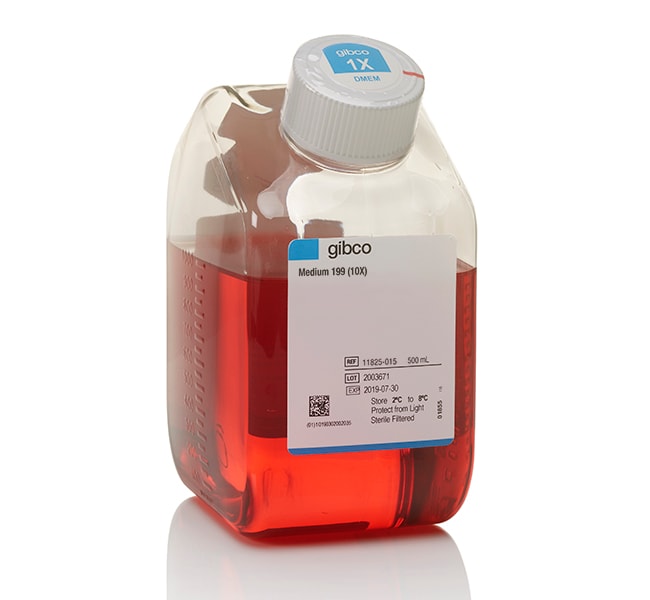Search Thermo Fisher Scientific

Medium 199 (10X)
| Catalog Number | Quantity |
|---|---|
| 11825015 | 500 mL |
Medium 199 was originally developed for nutritional studies of chick embryo fibroblasts. It has broad species applicability, particularly for cultivation of non-transformed cells. Medium 199 is widely used in virology, vaccine production, and in vitro cultivation of primary explants of mouse pancreatic epithelium, and rat lens tissues. We offer a variety of Gibco™ Medium 199 modifications for a range of cell culture applications. Find the right formulation using the media selector tool.
This M199 is modified as follows:
| With | Without |
| • Phenol Red | • L-glutamine |
| • HEPES | |
| • Sodium Bicarbonate |
The complete formulation is available.
Compared to other basal media, Medium 199 contains unique components, including adenine, adenosine, hypoxanthine, thymine, and additional vitamins. Medium 199 is available with Earle's salts for use in a CO2 incubator, or with Hanks' salts for use without CO2.
Product Intended Use
For in vitro diagnostic use. CAUTION: Not for human or animal therapeutic use. Uses other than the intended use may be a violation of local law.
Medium 199 contains no proteins, lipids, or growth factors. Medium 199 uses a sodium bicarbonate buffer system (2.2 g/L) and therefore requires a 5–10% CO2 environment to maintain physiological pH.
Concentrated forms of Gibco™ Medium 199 require sodium bicarbonate addition, pH adjustment, and filtration at the time of preparation (see protocol for details).
Shipping conditions: Ambient
Shelf life: 12 months from date of manufacture
Documents & Downloads
Certificates
Safety Data Sheets
Scientific Resources
Product Information
Frequently asked questions (FAQs)
Generally speaking, media can be used for up to three weeks after supplementation with serum. There are no formal studies to support this, but it is the rule of thumb used by our scientists.
Find additional tips, troubleshooting help, and resources within our Mammalian Cell Culture Basics Support Center.
We routinely ship media that require long-term storage in the refrigerator at room temperature. We have done studies on representative media formulations to show that media can be at room temperature for up to a week without a problem.
Find additional tips, troubleshooting help, and resources within our Mammalian Cell Culture Basics Support Center.
Very often mycoplasma contamination cannot be removed from the culture so it should be discarded. You may have a unique culture that you prefer not to discard and would like to try to clean it. Ciprofloxacin and Plasmocin have reportedly been used for this application. If interested in a protocol or directions for use, check with the antibiotic supplier or published literature. Note that mycoplasma are very difficult to remove from culture and spread easily so the treated cultures should be quarantined until clear of mycoplasma, and your laboratory should be thoroughly cleaned.
Find additional tips, troubleshooting help, and resources within our Cell Culture Support Center.
Try changing the medium or serum. Compare media formulations for differences in glucose, amino acids, and other components. Compare an old lot of serum with a new lot. Increase initial cell inoculums. Lastly, adapt cells sequentially to new medium.
Find additional tips, troubleshooting help, and resources within our Cell Culture Support Center.
This can occur if cells are overly trypsinized. Trypsinize for a shorter time or use less trypsin. Mycoplasma contamination could also cause this problem. Segregate your culture and test for mycoplasma infection. Lastly, check for attachment factors in the medium.
Find additional tips, troubleshooting help, and resources within our Cell Culture Support Center.
